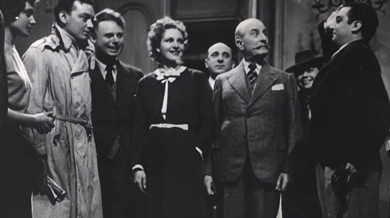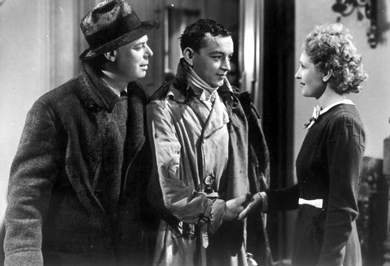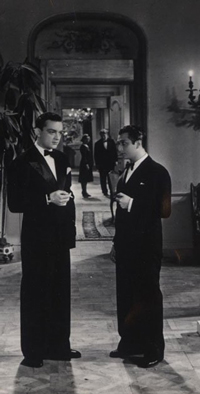
 |
|
|
|
In film school this Jean Renoir comedy was touted as a key French classic, but the prints available back then were so poor as to make it almost incomprehensible to students that didn't speak French. The Rules of the Game is a sophisticated satire that revolves around a madcap week in a country mansion where illicit loves and jealousies play out among the wealthy folk and their servants. It was reportedly a flop upon its release in 1939 but critics and boosters such as Orson Welles later elevated it to the status of one of the best films ever made. This Criterion special edition compiles the key research to let us understand the film, while restoring it to a visual polish not seen before. 
Life is good among the social set. Robert de la Cheyniest (Marcel Dalio) and his beautiful wife Christine (Nora Grégor) invite a mob of socialites to his country mansion La Colinière for a week of merriment and hunting. Among them are his long-time mistress Genviève (Mila Parély), her new amour, famous aviator André Jurieu (Roland Toutain), and friendly hanger-on Octave (Jean Renoir). Meanwhile, Christine's maid Lisette (Paulette Dubost) is avoiding her husband, gamekeeper Schumacher (Gaston Modot) to flirt with the scallywag Marceau (Julien Carette), a poacher newly promoted to bootblack. The guests try to sort out their private affairs in the very public country gathering, outdoing one another with their selfish desires and equally self-serving gestures of sophisticated tolerance. How does one make the right film at the wrong time, commercially speaking? Jean Renoir fashioned a critical satire of his society, making fun of the shortcomings and petty interests of well-to-do Frenchmen just as those same weaknesses seemed to be tilting the country unprepared into a new war. His characters are rich, vain, and lost in their own sense of romanticism. The people here all seek some kind of happiness through love but fritter their dignity away on cheap games that only prove the shallowness of their desires. Robert is obsessed with his hobby, mechanical music boxes and a giant musical wagon. These come to represent the order and sanity missing in the pointless charades played during the weekend of hunting. The leading lady wants the world to revolve around the problems of her heart, yet she assumes that everyone else's amours are cheap physical betrayals. A celebrity hero is a romantic dunce who thinks absconding with another man's wife is okay if one does it while obeying chivalrous rules of conduct. Robert is willing to prove his love by letting his wife go without a fight, when all he needs to keep her is let her know how irreplaceable she is. A slightly oafish fifth-wheel confidante throws himself into a romantic hysteria of his own. And the collected guests coolly observe the hanky-panky real and imagined, while congratulating themselves on their 'sophisticated' acceptance of it all. Renoir puts his ideas about class friction to work: the servants equal their masters for meanness and intolerance, denigrating their boss with their anti-Semitic remarks. The big difference between them and their employers is a lack of bourgeois 'sophistication'. When a husband in the servant ranks catches his wife with another man, a fight breaks out. 
Renoir's satire isn't about making people do outrageous things or giving them funny names -- there's not a single unlikeable character here. Robert is a sweetheart who wants everyone to be happy; the aggressive gamekeeper just wants his wife back. A rascal poacher is invited to work in the household, leading immediately to the same chaos seen in Renoir's Boudou Saved from Drowning. Robert's old flame sincerely believes his marriage is a bust. The aviator is not wicked, he just can't avoid his obsession with Robert's wife. Renoir himself plays the 'fifth wheel' friend, the one who enjoys everyone's confidence but innocently betrays them all. He wears a giant bear costume in the masquerade and becomes the story's clown. The story's message directly relates the film's petty events to the entire country's denial of the impending calamity. Renoir's character is the one to deliver it. Nervous Parisian audiences coming to The Rules of the Game expecting a reassuring comedy instead found a demanding and (then) shocking picture. No virtuous main characters emerge to set a moral tone. The ignorant attitudes of the rich (one woman thinks America was inhabited by Negroes before Columbus landed) aren't rejected or overruled by sentimentality. Just before the big party that comprises the story's second half, a graphic hunt scene shows in rapid cuts the slaughter of scores of birds and rabbits, many of them dying onscreen. The violence and shooting surely reminded audiences of the specter of war hovering on their doorstep, and the aloof hunters seem like inhuman monsters as they blast the game while making small talk about the cute squirrels in the trees. After that, the silly party games come off as reprehensible, and the tragic mix-up of the finale a conspiratorial cover-up by a corrupt class. Most of the excellent cast is unfamiliar to casual film fans. Exception Marcel Dalio is instantly recognizable from Casablanca. He had a long French career apart from his many memorable roles in American films. The kittenish maid Paulette Dubost enjoyed a 70-year stretch in comedies and classics like Lola Montés. Mila Parély is remembered as the mean sister in Beauty and the Beast. Julien Carette, the poacher, is a funnyman from Grand Illusion. 1 The gameskeeper Gaston Modot was a fixture in French and Spanish classics by Buñuel, Renoir, Prevért and Julien Duvivier (Pépé le Moko). I believe he was the surrealistic "hero" who sucked the toes of Dita Parlo in Buñuel's La Age D'Or. 
Consistently named one of the best pictures ever made, The Rules of the Game has been used as a model by many filmmakers like Woody Allen, Blake Edwards and especially Robert Altman, whose Gosford Park now seems practically a remake. The French original is not an easy picture to fully comprehend on a first viewing, especially when too much of one's attention goes to reading the wordy film's fast subtitles. But even if a lot of it slips by, you know you've just seen something incredible. Criterion's Blu-ray of The Rules of the Game looks pretty amazing for a film that was reportedly cut to pieces when new. The picture and sound are in great shape. Ironically, more commercially successful Renoir films from this era were over-printed, and don't look quite as good. The disc is appointed with a wealth of extras. The picture has a complex story to say the least, and several docus, interviews, and new materials take us right to the heart of the issues involved. Several pieces detail the restoration process. Renoir cut it drastically to 81 minutes right after the disastrous premiere, removing most of his own role. 3 In the 60s, the film was restored and actually made twelve minutes longer than it was at its premiere. Analytical side-by-side comparisons show how the shortest version changed the entire mood and tenor of the film via radical cuts in the last scene. These kinds of visual aids bring sense to a difficult film with a convoluted and misunderstood history. Savant confesses that before the Criterion disc, he really didn't understand the film at all. 2 Several substantial documentaries tell the story of Renoir's life and amazing career up to The Rules of the Game and the Second World War. The director and a host of subsequent directors explain and analyze his methods - composing in depth, dramatizing in depth, and keeping scenes running in complex, unbroken takes. The movie has a sense of freedom for actors and the camera that makes the narrative appear to be an unplanned series of events instead of a scripted story; many modern dramas seem constipated by comparison. Renoir's command and understanding of his characters is revealed in his long and lucid interviews -- he immediately makes sense of the character of Christine, explaining her muddled romanticism and changing moods as natural. There is no deeper reasoning behind her behavior, he says, there are indeed people who fall in and out of love every day. The full list of extras is below. Besides Renoir, the disc allows us to learn about other actors and people like Eugène Lourié, the art director. He and Renoir fled France for America, one because he was Jewish and the other because of his previous Communist associations. Criterion's DVD of The Rules of the Game had some contrast flicker and frame damage, most of which seem to have completely eradicated film and digital restoration methods are by now so well known that comparison featurettes are no longer needed. Clips of earlier versions in the docus show what the movie used to look like, and the improvement is amazing. Ditto on the soundtrack, which is almost free of distortion. For a film recovered after the original negative was destroyed in WW2 bombing, this looks terrific. Criterion's Joanna Schiller is the producer of this superlative disc set. The amusing cover artwork for the new disc is a great improvement over the older DVD.
On a scale of Excellent, Good, Fair, and Poor,
The Rules of the Game Blu-ray rates:
Footnotes:
1. Carette is one of the stars of a mysterious French film called Croisières Sidérales. It has a Twilight Zone - type story about Eisensteinian science messing up the romantic plans of space travellers who go faster than the speed of light ... and it was made in 1943! From all reports, the film is actually a musical comedy, and the space ships may be some kind of balloon .. (?)
2. Which brings up a question about film fandom. I'm a normal viewer in many respects and my initial reaction to The Rules of the Game is confusion and a slight disappointment. Then I read all the material and watch most of the docus and interviews in this disc, and I'm suddenly converted into praising the film as well. This makes me face some irrefutable truths: I'm not the most perceptive critic in the world, and I don't necessarily respond with aesthetic fervor to each bona fide classic I see. And that's okay.
3. It seems like Renoir got the critical drubbing that a decade before had been reserved for Abel Gance. Gance's problems with his distributors were about wild spending and chaotic production, but he aggravated them by casting himself in his films and attracting attention to his ego. In La fin du monde he played two roles, one of them a Jesus-like figure who gets crucified!
Reviews on the Savant main site have additional credits information and are often updated and annotated with reader input and graphics. Also, don't forget the 2011 Savant Wish List. T'was Ever Thus.
Review Staff | About DVD Talk | Newsletter Subscribe | Join DVD Talk Forum |
| ||||||||||||||||||